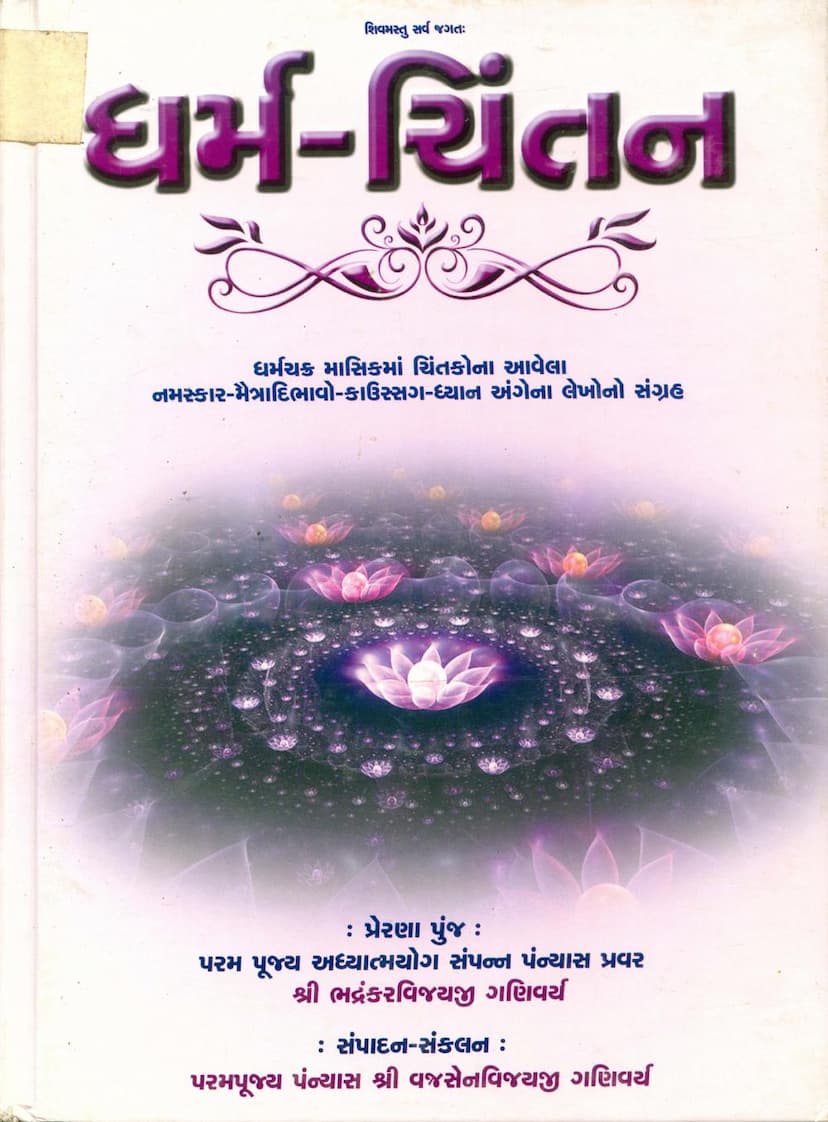Dharm Chintan
Added to library: September 1, 2025

Summary
Here is a comprehensive summary of the Jain text "Dharm Chintan" based on the provided pages:
Book Title: Dharm Chintan (ધર્મ-ચિંતન) Author(s): Vajrasenvijay (Compilation and Editing) Inspiration/Guidance: Panayash Pravar Shri Bhadrakarvijay Gani (પ્રેરણા પુજઃ પરમ પૂજ્ય અધ્યાત્મયોગ સંપન્ન પંન્યાસ પ્રવર શ્રી ભદ્રંકરવિજયજી ગણિવર્ય) Publisher: Bhandrakar Prakashan (ભદ્રંકર પ્રકાશન)
Overview:
"Dharm Chintan" is a compilation of articles originally published in the Jain monthly magazine "Dharmachakra" (ધર્મચક્ર). The book primarily focuses on spiritual concepts and practices within Jainism, with a particular emphasis on the Namaskar Mahamantra (નવકાર મંત્ર), the cultivation of virtues like Maitri (મૈત્રી), and the importance of Kaussarg (કાઉસગ્ગ) and Dhyan (ધ્યાન) in spiritual progress.
Key Themes and Concepts Discussed:
The book explores various facets of Jain philosophy and practice, aiming to provide guidance for spiritual upliftment and practical devotion. The core themes include:
-
The Significance of the Namaskar Mahamantra (Navkar Mantra):
- The book delves deeply into the power and essence of the Namaskar Mahamantra, presenting it not just as a mantra but as a complete guide to spiritual realization.
- It discusses how chanting the Navkar Mantra can help in overcoming internal obstacles like ego, anger, greed, and delusion.
- The mantra is described as a source of immense spiritual energy, capable of purifying the mind, body, and soul.
- Various aspects of its recitation, such as proper pronunciation, concentration, and the underlying feelings, are highlighted for effective spiritual practice.
- The text links the mantra to the ultimate goal of liberation (Moksha) and emphasizes its role in attaining a state of divine consciousness.
- The articles explore the subtle science behind the mantra, including the vibrational power of its sounds and their effect on the practitioner's well-being.
-
Cultivating Virtues and Positive Attitudes:
- Maitri (Friendship/Benevolence): The book emphasizes the paramount importance of developing universal friendliness towards all living beings. It is presented as a foundational virtue for spiritual progress, akin to a mother's love, fostering compassion and universal well-being.
- Karuna (Compassion): The text advocates for empathy towards the suffering of others and the desire to alleviate it.
- Mudita (Appreciative Joy): Finding joy in the happiness and good fortune of others is presented as a virtue that purifies the mind.
- Samata (Equanimity): Maintaining mental balance and equanimity in all situations, remaining unaffected by pleasure or pain, success or failure, is highlighted as a crucial aspect of spiritual development.
- Vairagya (Detachment): The book touches upon the importance of detachment from worldly pleasures and possessions, viewing them as temporary and ultimately unsatisfactory.
- Humility and Forgiveness: The necessity of humility and the power of forgiveness are stressed, not just in forgiving others, but also in seeking forgiveness for one's own faults.
-
The Path of Spiritual Practice (Sadhana):
- Knowledge and Bhakti (Devotion): The book distinguishes between mere intellectual knowledge and its practical application through devotion. True spiritual growth comes from experiencing and internalizing spiritual truths through heartfelt devotion.
- Dhyan (Meditation) and Kaussarg (Equanimity/Self-Absorption): The text explores the techniques and benefits of meditation and meditative states. It suggests that these practices help in controlling the mind, purifying thoughts, and attaining inner peace.
- Abhyas (Practice): Consistent and sincere spiritual practice is presented as the key to unlocking the soul's latent potential.
- Vow-Observance (Vrat/Niyam): The importance of adhering to vows and disciplines is highlighted for spiritual purification and progress.
- Self-Inquiry and Introspection: The book encourages regular self-reflection to understand one's inner state, identify faults, and strive for self-improvement.
-
The Nature of Reality and the Self:
- The text subtly guides the reader towards understanding the ephemeral nature of the material world and the permanence of the soul.
- It emphasizes that true happiness lies not in external possessions but in the realization of the true, eternal self.
- The concept of interconnectedness among all living beings is explored, promoting a sense of universal responsibility.
-
The Role of Gurus and Scriptures:
- The importance of guidance from a qualified spiritual teacher (Guru) and the study of scriptures (Shastra) are repeatedly mentioned as essential for understanding and practicing the spiritual path correctly.
Structure and Content:
The book is structured into various articles, each focusing on a specific spiritual concept. The compilation aims to provide a comprehensive overview of Jain spiritual disciplines. The author, Vajrasenvijayji, has diligently collected and compiled these insightful articles, drawing from the wisdom of revered saints and thinkers, with primary inspiration from the teachings of Shri Bhadrakarvijayji. The editor's message and the introductory notes highlight the book's purpose: to awaken spiritual consciousness and guide readers towards self-realization and liberation.
Overall Message:
"Dharm Chintan" serves as a spiritual guide, encouraging readers to engage in sincere devotion, cultivate virtuous qualities, control their minds, and ultimately strive for self-realization. It emphasizes that through consistent spiritual practice, particularly centered around the Namaskar Mahamantra, one can overcome the cycles of suffering and attain the ultimate goal of liberation. The book advocates for a life of detachment, compassion, equanimity, and selfless service, all rooted in a deep understanding and reverence for the teachings of the Tirthankaras.